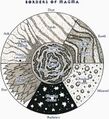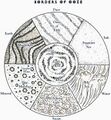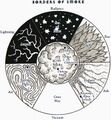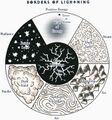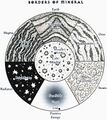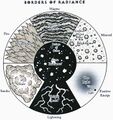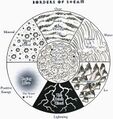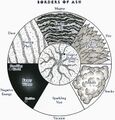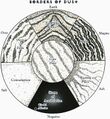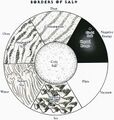Inner Planes

The Inner Planes is a term from Dungeons & Dragons introduced in 1e AD&D. It is a way of collectively referring to the planes that make up the "center" of the Great Wheel cosmology; the Elemental Planes, and the Energy Planes. By the admittedly biased beliefs of Sigilites, the Inner Planes are seen as, effectively, the boonies of the multiverse, being centered around more physical components than the more esoteric components of the Outer Planes, which are the realms of the dead and literal embodiments of the various moral alignments.
In their traditional layout, the Inner Planes consist of six primary planes; Earth, Air, Water, Fire, Positive Energy and Negative Energy. These six planes are then bolstered by the four Paraelemental Planes (convergences of two Elemental Planes) and the eight Quasielemental Planes (convergences of the Elemental Planes with the Energy Planes).
-
1e, Manual of the Planes
-
-
2e
-
Pathfinder
Elemental Planes[edit]


As their name suggests, the Elemental Planes are the origin point for all of the various forms of elemental matter in the multiverse. Traditionally, this has made them... rather visually uninteresting. The Plane of Fire, for example, is either an infinite 3-dimensional expanse of roaring flames or else an infinite expanse of ash fields, lava pools, and roaring flames beneath a "sky" of heatwaves and noxious combustible gasses.
In the Planescape book The Inner Planes, the border regions of the para- and quasi- planes, where they meet another plane, were staked out. This, of course, flies in the face of the fact that every elemental plane is supposedly an infinite 3-dimensional space and thus shouldn't have any borders.
Another downside to their elemental nature is that, well, the Elemental Planes are downright hazardous for anything that isn't an elemental of the right type, and sometimes even for things that are. If being roasted in the Plane of Fire or drowned in the Planes of Water and Ooze doesn't interest you, how about visiting the Glowing Dunes (Magma/Radiance), a technically infinite expanse of radioactive dust that will give you incurable and fatal radiation poisoning? This hazardous nature to visit has also led to many DMs finding them less than gripping - even in Planescape, the Elemental Planes are considered the backwater boonies of the Great Wheel, only marginally better than the Prime.
This led to the decision to do away with the Elemental Planes and replace them with the Elemental Chaos in 4th Edition to create a more interesting, more survivable, and more plot-generating form for them. Another mostly poorly received decision many vocal players complained that now the Inner Planes was just another Prime Material Plane but with extreme elemental magic themeing.
5e linked them to the Prime in a way reminiscent of Exalted, while also toning them down hastily by making it a plane people can actually live in rather than just the place evocation wizards store their fireballs. The 5e cosmology does not bring back the Quasielemental planes, while the Paraelemental planes are no longer bona fide planes of their own, but just the border regions where two elemental planes meet (much like those from Planescape mentioned above).
Air[edit]
Older Editions[edit]
A vast expanse of air. You better know how to fly. Gravity here is subjective, and you can alter the direction of "down" with a Wisdom check. If you can change direction fast enough, you can land safely. This is difficult at first, but you'll either learn or go splat, suffering up to 20d6 falling damage.
People make towns and castles on floating earth motes and magically solidified clouds. The main natural hazard is the many storms.
Earth[edit]
Older Editions[edit]
If you want to make your way around here, you better bring a way to dig. Holes grow shut on their own, so you better dig fast. Another issue is the lack of air: outside of pockets of air motes, there's nothing to breathe. Then there are the issues of earthquakes, gas pockets, the lack of a unified gravity, the darkness... it's a poor idea to come to the Plane of Earth without being very well-prepared.
5e[edit]
Its made up of chains of the tallest mountains, but most visitors enter honeycomb caverns that span under them.
Fire[edit]
Older Editions[edit]
Lots of fire here. Upon arriving, anything that can catch fire does so, and magical items are given a saving roll at a hefty penalty to escape this fate. Stone melts into magma, water vaporizes, and metal melts into slag. The higher your natural AC is, the more damage you suffer: humans suffer 6d10 damage, and by every 3 points your AC is lower than 10, you suffer 1d10 less damage all the way down to no damage at AC -8 to -10. At first. Going deeper gets even worse the further you go, culminating in a place with heat so intense it will incinerate anything, even creatures explicitly immune to fire, up to and including creatures with no physical body or animals which are literally made of fire. Air quality and visibility are obviously not great, but those are the least of your worries.
5e[edit]
A sun always hangs at the zenith, waxing and waning like a moon every 24 hours. It's blindingly hot and bright at noon and is a deep red twilight by midnight (which is usually the best time to travel and do business). Fierce winds and thick ash is always in the air, so always be covered up in a flame retardant scarf and goggles when not visiting a major inter-planer trading hub.
You only have to contend with Extreme Heat if your not going deeper into the plane, which your party will be fine as long as you expend spell slots so you have water every few hours so that hourly low DC Constitution saving throw doesn't get too hard (luckily they didn't also port over that Elemental Planes rule that you can't cast spells of opposing elements).
Water[edit]
Older Editions[edit]
You better be able to breathe water if you get here. There is nothing but water in all directions with zero water pressure, with pockets of air motes being a precious resource. Don't forget a way to see underwater or be able to deal with whirlpools, currents, pockets of acidic and diseased water, and of course, the predators.
5e[edit]
5e it's the Water world, extreme addition. Like the feywild, anyone traveling by sea could accidentally wander in. Having an actual surface, most landmasses are massive coral reefs that poke above the surface and extend down for infinity or are makeshift flotillas. You may not immediately know you are not in Kansas anymore, but when it's not calm, it's the most extreme you can imagine a plane of oceans can get. Rare times you will get massive tsunamis that span a good part of this infinite plane.
Energy Planes[edit]
Like the Elemental Planes, the Energy Planes (originally called the Material Planes, and including the Prime Material) represent the fundamental forces of creation; Positive Energy and Negative Energy, or, more simply, Life and Death. This makes them amongst the most featureless and hostile planes in the entire Planescape cosmology, as the former overloads your body with energy until it disintegrates from the strain and the latter flat-out kills you. The Energy Planes meet all four Elemental Planes, creating four Positive Quasielemental Planes and four Negative Quasielemental Planes.
In 5e's altered version of the Great Wheel, the Energy Planes are moved out of the Inner Planes, thus eliminating the Quasielemental Planes in the process. Instead, they lie to the extreme "north" and "south" of the Wheel, enfolding the entire multiverse and providing the raw forces of life and death that allows for existence to be possible. This edition stops trying to pretend that there's any point in going to either plane; it doesn't even bother describing them beyond a single paragraph on page 43 of the 5e Dungeon Master's Guide.
Positive Energy[edit]
Originally called the Positive Material Plane.
The Plane of life itself. You heal at an astonishing rate here, and healing spells heal far more. You gain 2d6 hit dice in extra HP... but once you hit double your normal HP you explode into a cloud of gibblets because your body couldn't handle the energy. The blinding light will burn your eyes out if you're not protected and you can't breathe here, but any suffocation damage will heal as quickly as you suffer it. This is not a nice place to visit.
The only structure here is the Fortress of Life, a magically protected citadel built by the the planewalker Feadal Didam-Hurus. Feadal uses the fortress to store balls of concentrated positive energy called lifepearls that she harvests from the plane. A lifepearl has the combined powers of a staff of curing and a rod of resurrection, and can be used 4d10 times until it explodes in a fireball.
Negative Energy[edit]
Originally called the Negative Material Plane
This place will decay and rot any living thing in seconds, and it can rip your soul out and turn you into an undead creature in mere seconds. Making your way around here is difficult and dangerous because of its lack of anything that's not soul-draining powers, which is made even more difficult by the hordes of incorporeal undead in the place and the fact that you can run into goddamn Shiva, who's the only deity who drops by the place now and then. Some spots called "Doldrums" aren't quite as immediately lethal, but still shouldn't be stayed in for very long.
The only friendlies here are a bunch of Dustmen maintaining the Fortress of the Soul, a skull-shaped outpost maintained only barely by their combined effort. If they find a lost non-undead on the plane they'll take them in for a few days: once a week a portal to Sigil opens up inside here and the lucky sod is sent on his way.
The Dustmen also maintain the Court of Woe here. This courtroom built almost entirely out of desiccated bodies is presided over by a lazy Nalfeshnee who rules based on how he's feeling that day. There is really no point to it being on the Negative Energy Plane, as the court has no windows and no entrances or exits except for the portal back to Sigil.
In 5e, to make things even more complicated, any time someone enters the Negative Energy Plane, a shadowy monster called a Nightshade takes their place on the plane they came from as a counterbalance, and you can't leave the plane until your nightshade returns.
Paraelemental Planes[edit]
The meeting grounds between the various Elemental Planes. Air and Water, Water and Earth, Earth and Fire, Fire and Air; they all produce a Paraelemental Plane. Air and Earth as well as Water and Fire don't have one, because those planes don't touch.
Ice[edit]
Renamed the Frostfell in 5e.
This is the Paraelemental Plane where Air and Water meet, which makes a little more sense than you'd think if you know how ice is formed, but probably has more to do with "snow is frozen water that falls out of the sky".
Moving around you'd swear that this place has an "up" and a "down" as if it were a big icy mountain. Which is kind of true: the "summit" reaches towards the Plane of Air while the "base" floats in the Plane of Water like a massive iceberg. But these are just the outer layers of the plane: near the center of the plane, it becomes so cold even those immune to cold suffer because of the cold. Here it is so cold even light freezes and it becomes impossible to see, and even speaking or thinking requires a Save VS Petrification. The cold deals 1d6 points of damage per turn, which becomes 1d6 per round if you dress in many layers and stay out of the wind and water. And don't think about digging: passages grow shut in a matter of days. Oh, and there are avalanches and sinkholes too. The plane's also got spots of True Cold, where things like concepts and thoughts can freeze solid. If obtained such things can be thawed out and captured to be used in magic or sold for profit.
Yetis, Remorhazes, white dragons, and other related cold creatures as you can imagine living here. Apparently, these kinds of territorial creatures and temperatures give a strong warning that planer travelers have a better chance of survival flying through its snowstorms than setting foot on its Icy ground.
Magma[edit]
Originally called the Plane of Heat, and renamed the Fountains of Creation in 5e.
In case it's not obvious, this Paraelemental Plane embodies the overlapping of Fire and Earth.
Ever played "the floor is lava" as a kid? Good, because here everything is lava. Breathing is difficult, everything catches fire, magma bubbles up, you suffer damage based on your natural AC (but it's only d8 instead of d10), clouds of hot gas mess you up unless you're immune to acid and fire. Lava surfing is actually how most nonnatives get around here.
Home to Azers, Fire Giants, and Red Dragons.
As of 5e, this is speculatively the current site of Cavitius, the citadel of the lich Vecna, as it mentions it's on the borders between the Planes of Earth and Fire but also says it's in a vast field of ash? Crashing his place is a bad idea, and not just because of all the incorporeal undead roaming the place.
Ooze[edit]
Originally called the Plane of Vapor, and renamed the Swamp of Oblivion in 5e.
Earth and Water converge in this Paraelemental Plane.
The trash heap of the multiverse, Ooze is made of all sorts of muck, mud, unpleasantness, and highly potent acid that can deal up to 1d20 damage per turn with a -4 on your save. Breathing and seeing are difficult here as well. Settlements must be built on top of tall poles or trees (yes, apparently, Ooze has trees), but even then, they have to be constantly rebuilt and maintained, as everything slowly sinks and melts on top of surprisedly existing trees. Homes have to be repeatedly rebuilt as everything slowly sinks.
Many beings and even realms amongst the planes use the place as a trash heap, including Sigil. Thing cast into the muck typically can't be found again for a century. If you're willing to pick through the junk, you might find something of value, like an artifact that the owner failed to send to the Negative Energy Plane. Whether or not whatever you find will be "worth" spending time raking around on (and in) Ooze is another question.
One of the more unusual inhabitants of the plane are a group of gnomes, who accidentally ended up in the place whilst digging a mine in the Plane of Mineral. They ended up making a raft to ride the Ooze and, well, you know gnomes: their raft is now some 500' in diameter, and they're doing quite well for themselves.
Smoke/Ash(5e)[edit]
Originally called the Plane of Dust, and renamed the Great Conflagration and the Plane of Ash in 5e to confused veteran planescapers.
This is the Paraelemental Plane created by fusing Fire and Air.
You better be good at holding your breath, because if you breathe this smoke you'll start taking progressively higher amounts of Con damage over time (and that's if you don't hit a pocket of really poisonous gas). The smoke is also difficult to see through, very hot in certain spots, and on occasion even explodes. While it's technically survivable, it's not a very nice place, even when you discount the Smoke being the primary battlefield of the wars between the Djinn, and Efreet. In case you want to join them: the Djinn treat their men better while the Efreet pays better. Some of the smokes in Smoke/Ash are useful for a variety of magical or recreational purposes, and a few individuals come to the place to harvest and sell them for profit.
Quasielemental Planes[edit]
What if we had one of the energy planes one of the four core elemental planes, we get the most extreme example of Overwhelming Vibrence or entropy to the plane energy. Like their respective energy planes, the Positively charged panes will kill you with overabundance but are still one of the best places to grab raw materials for crafting your artifacts and epic-level magics. The negative side are the runners up for the best places to kill someone or obscuring and secure a location from wandering Planeswalkers that have a habit of busting through your environmentally sealed walls rather than the front portal door to your BBEG's interdental Fortress like normal JRPG protagonists.
As of 5e with no elaboration on what in the positive or negative planes, non of the Quasielemental Planes never got mentioned and probably retconned by omission with one of the paraelemtnal planes renamed taken from a Quasielemental, and new lore of Vecna's citadel Cavitius is now in the plane of magma.
Ash/??(5e)[edit]
You know how at the end of Dark Souls 1 and 3 you wade through those blasted ashen hellscapes? The Plane of Ash is kinda like that, except this time it sucks the heat right out of you. 2d6 damage per turn, and 1 HD of damage if you're from the Plane of Fire, Magma, Smoke/Ash(5e) or are otherwise used to extreme heat. Magic can prevent this, but mundane sources of heat cannot. The clouds of ash make seeing and breathing difficult, and sometimes the ash eats magic. If you're dumb enough to get large patches of ash wet you end up with a mix of quicksand and quick-dry cement. Step into a puddle of ashen sludge and it hardens immediately, getting your ass stuck for good unless someone can save you. And that's discounting the pockets of negative energy that'll drain your Hit Dice if you step into them. Moving around is rather easy: you'll have to dig but the digging is light work. The Plane of Ash is the former site of Cavitius, the citadel of the lich Vecna. Crashing his place is a bad idea, and not just because of all the incorporeal undead roaming the place.
With 5e renaming the Plane of Smoke to Ash, now the microscopic portion of new and old-schoolers that had bothered to read about the obscure inner planes will be confused.
This is the Negative Quasielemental Plane of Fire.
Dust[edit]
When rock is ground down to its smallest possible particles you'll get dust. This is a place of darkness and the decay of things. This can also include you: every hour spent on the Plane of Dust will have you roll a save VS breath weapon. Failure is a 2d6 damage hit. And if you hit 0, you disintegrate. Healing spells don't work here, unless you also cast something like Restoration or Negative Plane Protection. Vision is all but impossible because of all the dust. The lack of oxygen means that breathing is impossible and fire will peter out in moments. Sometimes the dust will cling together into strands that can capture a creature and start to drain their attributes, levels or even a decade of their life. The only way to deal with these strands is via a Disintegration spell. On top of that, the dust will frequently kick up into dust devils that can disintegrate matter in the blink of an eye and the nigh-invisible pockets of negative energy can drain you of your Hit Dice. Overall, the Plane of Dust is not a very nice place.
Dust is where the influences of Earth and Negative Energy overlap to create a Quasielemental Plane.
Lightning[edit]
Stay here long enough and you can say that you've been... THUNDERSTRUCK. IF you carry more metal on you than a dagger you'll get hit by a lightning bolt for 1d8 x 10 damage. Even if you're not, you have a flat 10% chance per round spent here. You can breathe the air (it smells of ozone) here, but it won't do you any good because of the lightning, deafening thunder and the occasional pocket of plasma which can hit you for 20d10 damage if you touch it.
This is the Positive Quasielemental Plane of Air, simply because lightning has a very long tradition of being the elemental energy most associated with Air.
Mineral[edit]
A lot of valuable rocks in this place, but the creatures living here don't like to share (nor do they like intruders). Aside from requiring the same digging as on the Plane of Earth, the big issue here is the fossilization. Once per day you'll have to save against petrification: if you fail you turn into a mineral shape of yourself, and will likely end up either being mined or eaten by some thing or another. Another problem is that all the sharp crystaline formations here can cut you up real bad if you move fast and carelessly, so do be careful.
Mineral is the Quasielementl Plane where Earth and Positive Energy overlap.
Radiance[edit]
What do you get when you take fire and remove the fire, but keep the warmth and light? You get Radiance. This place will light you up good in more ways than one. Aside from being able to set you on fire like the Plane of Fire. On top of that, the brilliant light of this place is beautiful but it can also blind you in seconds. Moving around here is like navigating the Plane of Air, except you'll need a blindfold and a way to protect yourself from the heat.
As you can probably tell from that description, this is the Positive Quasielemental Plane of Fire.
Salt[edit]
The plane of those who are still waiting for a 5e supplement for Planescape, the Plane of Salt is what happens when you remove all the water and life from the ocean: you'll end up with nothing but salt. An endless block of alkaline matter, the Plane of Salt thirsts for your fluids. Merely being here without magical protection deals 2d6 damage per round, and aquatic creatures suffer 1 Hit Die of damage instead. This'll leave even the toughest of planewalkers mummified corpses in seconds. As a large body of matter one has to dig to make their way through and bring their own light and air. The second lethal feature of the Plane of Salt is the sharp crystal veins: if you fall into an area that has them you have to save VS breath weapon. Even if you make the save you can suffer up to 2d8 damage, and if you fail you'll either lose a limb or get bisected or even beheaded. So watch your step around here!
Water meets Negative Energy in this Quasielemental Plane.
Steam[edit]
A bit of an odd duck, Steam is not as hot as you'd think. It's actually quite cool, unless you walk into one of the pockets of hot vapor. This is by far the most accommodating (as in: least lethal) of the Quasielemental Planes: being here puts someone under the effect of a Slow spell because breathing is difficult, and with a simple casting of Water Breathing that problem's fixed. Moving around can be done by either falling or swimming, but the latter is more advised because the steam prevents you from seeing something you're falling towards. As such, moving around with an air ship or a local flying creature called a Fabere is advised.
One of the more confusing Quasielemental Planes, your first instinct with Steam as a plane of existence would be "Fire and Water", right? Well, in Planescape, you'd be wrong; this plane embodies the overlap of Water and Positive Energy.
Vacuum[edit]
The Plane of Vacuum is the plane of nothing. There is nothing here. Well, not entirely. Like outer space the Vacuum is dark and empty, but unlike space it does have temperature and pressure. Sure, they're both low, but it's not going to outright kill you. As long as you have access to air to breathe (gaseous creatures will suffer 1 HD of damage per round) and a light source that doesn't need air (like fire) you're good to go like you were in a dark version of the Plane of Air. What does carry over from regular space is vacuum welding. To keep it simple: the lack of air to get between moving metal parts means that said parts will get stuck together and can't be moved while on the Plane of Vacuum. There's a few creatures out here who can survive in the vast nothing, but those are all rare and exceedingly tough. Oh, and watch out for the naturally occurring Spheres of Annihilation!!!.
This absolute void of nothingness represents the influence of Negative Energy on the elemental plane of Air.
Border Regions[edit]
A solution to stop writers from falling down the rabbit hole of inventing a needlessly infinite combination of planes. Are the planer areas that touch the transitioning line between two bordering planes (duh). Not planes in that of themselves (less we invite Border planes for the Border planes); they maintain the main characteristics of the plane you are on but with strong influences from its neighbor.
Sirocco Straits: Ash /Fire. The air and earth motes are Hot and dry. Here you find Gargoyles and their allies from the Plane of Earth staging theirs on the plain of fire.
Mistral Reach: Ice/Water. It only rains the closer you are to the plane of water. In these regions, the storms become snowstorms, and things get covered in ice and snow.
Silt Flats: Water/Ooze. It's all muddy sludge water.
Sea of Ice: Water/Ice. Not to be confused with the Sea of "Moving" Ice on Faerun. Here be ice sheets, icebergs, and Vikings riding those icebergs. Turning your ship into an icebreaker would be recommended if you sail through.
Furnaces: Magma/Earth. Here is where Dao set up their forges.
Mud Hills: Earth/Ooze. Mountains are continually melting way into sloppy mud hills before being pushed into the plane of Ooze by new mountains.
Shimmering Drifts: Ice/Lightning. This place is quite strange. Ice and snowstorms would be punctuated by flashes of lightning but little in the way of thunder as the ice and snow block the sound. The combination of lightning damage and freezing to death means people would likely find freeze-fried corpses of past travelers.
Precipice: Air/Ice. Towards the direction of Air, it resembles a howling blizzard, slowly growing weaker as one draws further from the border. Towards the direction of Ice, the infinite ice of the plane breaks to a surface, resembling the arctic lands of any number of Prime worlds.
Frigid Void: Ice/Vacuum. Cold is the only thing that exists in this place, with ice and snow replacing the blackness as you get closer to the Ice side.
Fog of Unyielding Frost: Ice/Steam. The vapor here is super cold, and breathing it will probably freeze your lungs from the inside out.
Sea of Frozen Lives: Water/Ice. The water here is just above freezing, and the closer to Ice you get the more ice chunks start appearing in the ocean until it's just a big chunk of ice with a bunch of streams running through it.
Stinging Storm: Salt/Ice. Acrid, metal-dissolving blizzards of dry ice, desiccating salty winds, and snowdrifts that will dissolve your boots make this a thoroughly unpleasant place to be.
Choking Gale: Ooze/Steam.
Bile Sea: Ooze/Water.
Stagnant Sea: Ooze/Salt.
Slag Marshes: Ooze/Mineral.
Muckmire: Ooze/Earth.
Oasis of Filth: Ooze/Dust. Imagine an oasis in the Sahara in the middle of a dust storm. Now make the water cover the ground and replace it with acidic sludge. This place is a nightmare, with travelers risking disintegration and acid burns constantly and nothing of value to justify going.
Obsidian Forest: Magma/Mineral.
Scorched Wastes: Magma/Earth.
Sands: Magma/Dust.
Glowing Dunes: Magma/Radiance. Basically an endless volcanic desert, save for the fact that every grain of sand is so radioactive it makes Chernobyl Reactor 4 look like a sauna! Visiting is generally a terrible idea, though for the more intrepid weapons makers or Dr. Evil-style villains, think of all the nukes you can make! It must be repeated, DO NOT go there unless you're a Warforged or some other race that's unaffected by radiation, or you WILL become a screaming pile of sludge and bones in a few days.
Searing Mists: Magma/Fire.
Chalk Islands: Magma/Ash.
Sea of Stars: Smoke/Radiance.
Scald: Smoke/Fire.
Embers: Smoke/Ash.
Aurora: Smoke/Lightning.
Eternal Haze: Air/Smoke. The temperature is more survivable than it is in the Plane of Smoke, but it's still hard to breathe unless you're close to the Air side.
Gray Way: Radiance/Vacuum
Subdued Cacophany: Air/Lightning. As the name implies, the endless storms are less intense here, making it a decent place for a traveler to rest.
Glistening Crystal: One of the most unusual planes. Through means unknown to science the snowflakes and ice crystals here generate static charge as they are whipped around by the wind. The result is a freezing cold blizzard that can electrocute adventurers at any moment. The only upside could be capturing part of the storm to use as a power source.
Dark Land: Ash/Lightning. Resembles the static lighting clouds seen coming from a volcanic eruption. The ashes may be cold but their constant friction makes the static charge from the lighting far more dangerous. Best avoided for these reasons and the lack of anything valuable.
Wall of Energy: Basically a wall of continuous electrical energy capable of frying you to dust the second you planeshift over. Only use that can yet be found for this might be as some sort of Death Star-style magic superlaser. All that electrical energy might be useful in many applications, if it were easier to harness.
Islands of Water: Steam/Water. The name isn't far off the mark. Consists of large spheres and other bodies of water with steam and air floating between the large pockets. As long as you can swim, breathe underwater, and fly between the "islands" this could make for a unique place to live. The water floats around like it's in freefall, sometimes bits of the larger bodies of liquid split off to form new bodies and get bigger by absorbing others. Merfolk swimming through the air between floating kingdoms sounds awesome.
Realm of Cloying Fear: Steam/Ooze. Easily one of the most disgusting realms in the Elemental Planes, the acidic and toxic nature of the Plane of Ooze is mixed with the cold, damp nature of Steam. The evaporated and clinging filth acts like cold acidic glue, making breathing, walking, swimming, or anything else you try painful and exhausting. Even casting Waterbreathing doesn't help as you would then be getting acid straight into your lungs, burning you from the inside and outside.
Hoarfrost: Steam/Ice.
Shard Forest: Steam/Mineral.
The Death Cloud: Steam/Lighting. One of the deadliest locations in the multiverse, all the moisture from steam makes lighting conduct like everything is covered in copper. If you manage to get here you'll likely be electrocuted within seconds. The charged steam is also much hotter than the rest of the plane as the plasma superheats everything and can melt off skin as well.
Raging Mists: Steam/Positive Energy.
Unnamed Border: Mineral/Earth. They're so similar to each other in this region it's nearly impossible to distinguish where one ends and the other begins. There are a few air pockets.
Natural Forge: Mineral/Magma. While dangerous, you won't find a better casting furnace in all the planes. The molten rock from the plane of Lava gives way to red hot pockets of molten precious metal. The locals won't like it if you start removing the valuable resources, but think of the quality of weapons a blacksmith could make for the wizard willing to bring him some!
Sparklemire: Mineral/Ooze. Basically a swamp filled with precious metal and gems, most of which are being released as the acid eats away at the surrounding rock that holds them. The swamp glitters with the presence of all the gems and metal nuggets, but watch out! Most everything needs to be neutralized before it can be used or the acid will continue to do its work.
Misty Caverns: Mineral/Steam.
Gemfields: Mineral/Positive. Here, the gems aren't just sharp and deadly, they glow and burn.
Brightflame: Radiance/Fire. A massive eternal firestorm, where the flames have all possible colors, forming a rainbow of fire. Needless to say, going there without some form of fire resistance will bring a painful and firey death just like in the main Plane of Fire, only you'll burn in every color of the rainbow instead of the usual orange-red.
Sea of Stars: Radiance/Smoke. Basically a nebula, filled with dark clouds full of nascent stars glowing through them.
Bright Land: Lightning/Radiance. A blinding storm of rainbow colors and plasma. The multicolored storms can toss people around like ragdolls.
Brighthome: Mineral/Radiance. It's a big cave full of glowing crystals and is home to a bunch of mining communities. It's similar to the Gemfields, but nowhere near as deadly. The Kingdom of the Blind is located here, as it's the safest region in both planes and home to most of the outsiders who live there.
The Light: Radiance/Positive Energy. Basically the inside of a star, hot and bright and not much else. Strangely, you won't burn inside it, and the sheer energy of the plane can heal wounds. Right at the edge of the Positive Energy plane is The Heart of Light a.k.a. the Tower of Healing. Basically the ultimate place for healing injuries of the physical body.
Saline Sea: Salt/Water. Imagine the Dead Sea and you get the start of the idea. Water so amazingly salty that you can nearly wade through it, in spite of being hundreds of feet deep. Few people travel here, but there is one town built atop the briny water. The residents are shifty though, and may well try to eat you to suck the moisture from your blood.
Stagnant Sea: Salt/Ooze. Uniquely unpleasant, the acidic sludge and ooze of the sea quickly solidifies as the salt absorbs all the water, or being absorbed as new muck moves in. The acid-burned, mummified corpses of previous visitors don't last long before they are reduced to goo themselves. If it wasn't so desiccating Juiblex would feel right at home.
Consumption: Salt/Dust. This hellhole combines the worst aspects of both. Staying here for any length of times risks disintegration. The desiccating ground must be waded through, though at times it's deep enough to be submerged in.
Flats: Salt/Vacuum. It's just a giant sheet of reflective salt beneath an airless void.
Crystal Range: Salt/Negative Energy.
Tumbling Rocks: Dust/Earth
Wasting Place: Dust/Ash.
Storm of Annihilation: Dust/Negative enrgy
Sea of Frozen Flames: Ash/Fire.
Cinder Wells: Ash/Magma.
Sparkling Vast: Ash/Vacuum.
Empty Winter Ash/Negative Energy.
-
Ice borders
-
Magma borders
-
Ooze borders
-
Smoke borders
-
lighting borders
-
Mineral borders
-
Radiance borders
-
Steam borders
-
Ash borders
-
Dust borders
-
Salt borders
| Great Beyond of Pathfinder | ||||
|---|---|---|---|---|
| Heaven | Nirvana | Elysium | ||
| Astral Plane-Ethereal Plane | ||||
| Axis | Material Plane-Boneyard | Maelstrom | ||
| First World-Inner Planes-Shadow Plane | ||||
| Hell | Abaddon | Abyss | ||































